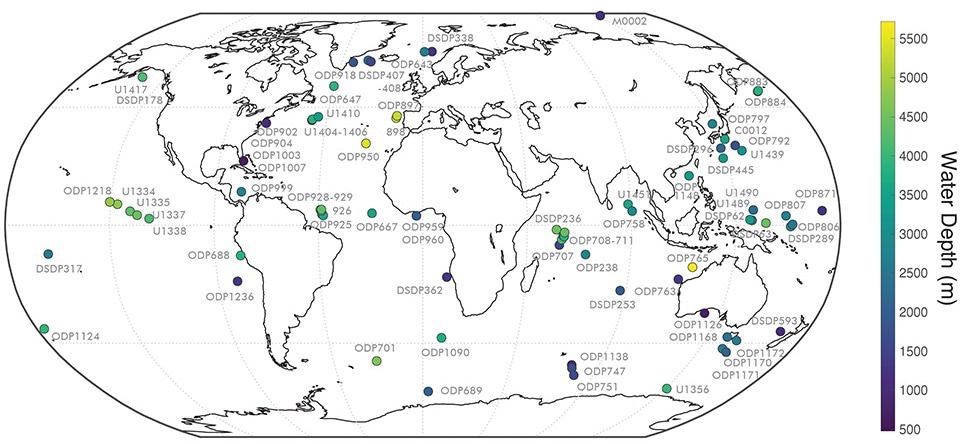A new technique has been utilized by scientists from the UK, the USA, and Bremen to evaluate the rate at which the sequestration of organic carbon was done in marine sediments at the time of the Earth’s Neogene period.
 For the study, the team used data collected by the IODP drilling program and its predecessors over more than 50 years. For this, marine sediments from 81 sites were analyzed to calculate organic carbon deposition rates. Graphic: Mark Torres, Rice University
For the study, the team used data collected by the IODP drilling program and its predecessors over more than 50 years. For this, marine sediments from 81 sites were analyzed to calculate organic carbon deposition rates. Graphic: Mark Torres, Rice University
This method has proven to be a lot more accurate compared to the conventional method and can thus make a significant contribution to understanding climate change and mitigating its effects.
The researchers' study outcomes have been published in the scientific journal Nature.
Oceans serve as a sink for carbon - this ultimately means that carbon from the atmosphere is stored in the oceans. However, there is a clear distinction between organic and inorganic carbon. The organic carbon bound in marine sediments is also classed as a source of oxygen.
Until now, it has been common practice to determine the mass balance between inorganic and organic carbon – but this method is considered inaccurate. A team from the USA, Great Britain, and Germany has now created an alternative method - their goal being to better determine the rate of carbon over a longer period of time.
Our results support the assumption that rates were high in the early Miocene and Pliocene and low in the middle Miocene.
Dr. Ziye Li, Study First Author, Center for Marine Environmental Sciences, University of Bremen
Li stated, “We calculated the mass accumulation rate of organic carbon directly from the organic carbon content of marine sediments. This is possible thanks to standardized measurements combined with well-validated age models from sites from the international drilling program IODP and its predecessors DSDP and ODP.”
“Traditionally, estimates have been based on the isotopic composition of carbon, which requires, among other things, a number of assumptions about carbon sources and key fluxes within the carbon cycle,” says Li, who works at MARUM in the Low Latitude Climate Variability group.
Our new results are very different – they are the opposite of what the isotope calculations are suggesting. I was really surprised how wrong our current ideas might be.
Benjamin Mills, Study Co-Author, University of Leeds
Mills is an expert on the established isotope methods.
Li, along with her collaborators, had an assumption that carbon sequestration, or its absence, has been a concern to temperature-dependent bacterial decomposition of organic matter during the middle Miocene’s warm period.
Thus, this feedback mechanism would be expected to play out during other warming intervals in Earth's history, as well as in any future warming of the global ocean.
As we warm up the ocean, it will make it harder for organic carbon to find its way to be buried in the marine sediment system, and that is what we have found in our study – the lowest rates of carbon sequestration happen when the planet was warm. So that’s not helping from this perspective, in terms of the issues that we’re facing in the present day.
Yige Zhang, Study Co-Author, Texas A&M University
But the study performed by the team has indicated that this respiration-like process helps stop organic carbon sequestration by decreasing carbon dioxide emissions into the air. When bacteria process the organic carbon, it is sent back to its original form as CO2.
Ziye Li, the first author of the study, calls the team’s work the start of a potentially considerable new method for data analysis that could help comprehend climate change and reduce its effects.
Journal Reference:
Li, Z., et al. (2022) Neogene burial of organic carbon in the global ocean. Nature. doi.org/10.1038/s41586-022-05413-6.